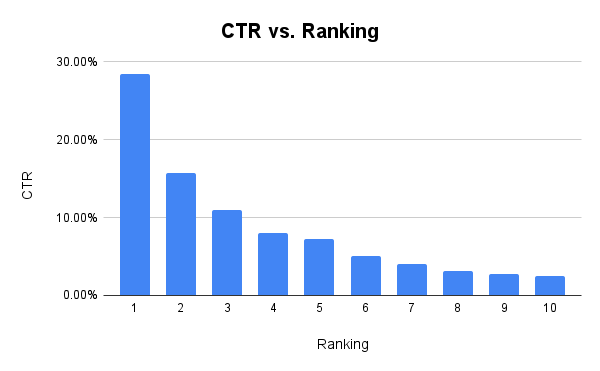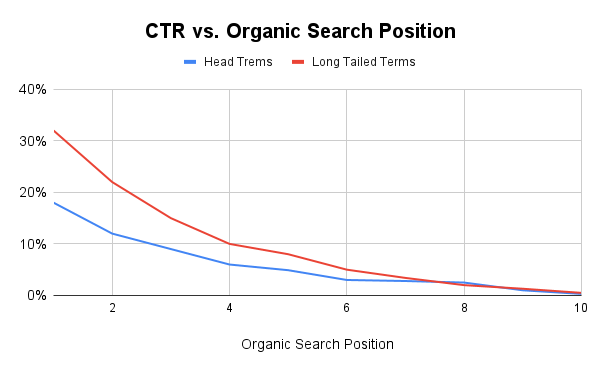What Is Organic CTR?
<< Dwell Time
Bounce Rate >>
<< Dwell Time
Bounce Rate >>
What Is Organic CTR?
Organic CTR (Click Through Rate) is the percentage of people that click on your search engine result. It is the first step for turning searchers into visitors and then into customers.
As per Search Engine Journal, the pages having number one search rankings have a click-through-rate of 28.5%.
Sistrix, a tool that provides SEO data, analyzed billions of pages to understand CTR more.
They found that the page ranking in the second position has a CTR of 15% and the one ranking in the third position has a CTR of 11%.
So, do you see how the CTR falls drastically with each position!

Organic CTR is calculated by dividing clicks by impressions.
For example, your result showed up 1000 times (impression), and people clicked 50 times on your result (click), then your organic CTR would be 5%.
Importance Of Organic CTR:
Higher Traffic:
From the example above, you know that the more clicks, the higher the CTR will be. If I increase the clicks to 70 times in the same model, keeping the number of impressions the same, the new CTR would be 7%.
Increasing clicks directly mean more people visiting your website. Thus, an increase in traffic.
As per Moz, the second page on Google gets less than 6% of website clicks. As a result, they have a low organic CTR.
Higher CTR = More traffic
Search Engine Ranking:
Though organic CTR is not a direct ranking factor, there’s a correlation between them.
In one of his studies, Rand Fishkin explained that if Google finds that a page is getting high CTR, users like the content, and it interests them more than the average content on that query.
This will make Google rank up the page.

Increase In Conversion rate:
Increasing your CTR will give a boost to your conversion rate too. More clicks equal more traffic, and more traffic equals more customers.
As per WordStream, 2x increase in CTR will boost the conversion rate by 50%.
How To Measure Organic CTR?
To measure your organic CTR, you should know the keywords that your site ranks for, the number of clicks and impressions generated.
You can use various tools to find this data.
In Google Search Console, you can extract the data for keywords you have ranked for in the past three months.
Click on the Performance tab on the left-hand side.
A graph will come up showing the following parameters:

It will give you the data for your website.
If you scroll down, you will get a list of keywords along with the number of clicks and impressions.
Select any keyword, and the tool will give the CTR for it.

Best Practices To Increase Organic CTR:
Improve Title Tags:
Best practices for writing Title Tags:
- Your title tag should clearly describe what your page is about.
- Keep it between 50 – 60 characters. This will help you avoid truncation on the results page.

- Think about what makes your content unique and highlight it in the title. It could be its length, images, updated content, or even just your brand name.
- If you have covered A-Z on a topic in your content, use terms like a complete guide and step-by-step guide. It gives an impression to people that your content is one stop for all the information around that topic.

- Use brackets in your title tag: A study from Hubspot showed that using brackets in headlines increased clicks by 40%. They give the users a clear idea of what they are getting into.

- Use numbers in your titles: List posts give a clear idea to users about all the tips and tactics on a topic. They are also easy to read and understand.

Numbers can also be included in the title tag even when you don’t have a list post. For example:

You can use tools like CoSchedule’s Headline Analyzer to analyze your title.
You can also use Headline Studio to get the score and suggestions for your title.
For example:

Improve the URLs:
In a study conducted by Backlinko and Ahrefs, short URLs tend to have a ranking advantage over longer URLs.
They should not exceed 75 characters.

Your page’s URL should carry the main keyword. It helps the visitors understand what the page is about. If an URL looks confusing, it is less likely to be clicked and shared.
Use a hyphen in between words for better readability.
Improve The Description:
Though meta description is not a direct ranking factor, it helps in boosting the organic CTR. It summarizes the content users will see after they click on the URL.
Tips for writing a good description:
- Make sure that it doesn’t exceed 155 characters. Otherwise, it will get truncated just like the title tag.

- Use your main keyword, but don’t over-optimize around it.
- Introduce the readers to your topic.
- Highlight the features of your content and how they will benefit the readers.
- A clear call to action: for example: Buy now (if you are e-commerce), learn more about it, get it now, etc.
- Be emotional: sounding too commercial can disinterest your potential visitors. Appeal to them like you genuinely want to help them.
Rich Snippets:
A snippet is a name given to the result that shows up on Google’s results page. Rich snippets are results that carry additional information, like reviews, recipes, event details, etc.

When you offer extra information to users, it will interest them more than other regular results. They will give you a chance to come to the top of the page and increase CTR.
As per Rankpay, a rich snippet can increase the organic CTR by 30%.
Previous
<< Dwell Time
Next
Bounce Rate >>

